Isle of Wight adopts ‘ALL In’ plan to combat learning loss, absenteeism
Published 4:37 pm Thursday, December 28, 2023
|
Getting your Trinity Audio player ready...
|
Isle of Wight County’s School Board has approved a two-year spending plan for its $1.8 million share of state funds tied to Gov. Glenn Youngkin’s “ALL In” plan.
The initiative – an acronym for attendance, literacy and learning – aims to combat chronic absenteeism and boost scores on Virginia’s Standards of Learning exams. Youngkin announced the plan in September after scores from the prior school year showed schools statewide were still below their pre-pandemic pass rates.
Youngkin signed bipartisan legislation in a special September session of the General Assembly that allocated an additional $418 million to Virginia school divisions. To receive their share, divisions were required to submit spending plans to the Virginia Department of Education.
IWCS Superintendent Theo Cramer submitted his plan on Nov. 29. In accordance with a VDOE standard requiring 70% be put toward high-intensity tutoring in grades 3-8, Cramer’s plan allocates $1.1 million to pay “select contracted teachers” an additional $50 per day to provide the tutoring, and sets pay rates of $25 to $35 per hour for outside tutors and instructional assistants engaged in tutoring before, during and after the school day.
State Superintendent Lisa Coons approved Cramer’s plan on Nov. 30. The School Board also approved the plan in a unanimous Dec. 14 vote that requests Isle of Wight’s Board of Supervisors accept and forward the $1.8 million to IWCS.
According to IWCS Deputy Superintendent Susan Goetz, the tutoring will consist of roughly 30 minutes per day of direct instruction by an in-person tutor and 30 minutes of online learning three to five days per week.
IWCS previously received tutoring grants from federal pandemic relief funds. As of Dec. 14, just over $325,000 remained of the Elementary and Secondary School Emergency Relief, or ESSER, grant for in-school tutoring, and just over $134,000 remained of the grant for before- and after-school tutoring. The federally funded tutoring is ongoing and Goetz expects to spend the remaining ESSER funds by the end of the current school year.
Goetz said Isle of Wight’s goal is to identify students using SOL scores, other assessments and teacher recommendations for the ALL In tutoring who are not already receiving intervention through the ESSER program. The ALL In tutoring, she said, is slated to start in February.
Cramer’s plan calls for an additional $530,664 to be put toward a new VDOE-approved reading curriculum for kindergarten through eighth grade, in accordance with a provision of the ALL In plan that calls for 20% of the money to go toward compliance with the 2022 Virginia Literacy Act. The act requires school divisions to use “evidence-based literacy curriculum” and staff a sufficient number of reading specialists to support interventions by the start of the 2024-25 school year.
A committee of teachers from each school will select a new curriculum from VDOE-approved resources in January through March. Goetz warned that local dollars may need to supplement the state funding, as a cost of “close to $1 million is not uncommon” when purchasing a new literacy program.
The remaining $178,006 will be spread across the current and 2024-25 school years to hire an “attendance officer” to address chronic absenteeism, which the state defines as missing 10% or more of the school year.
“Our schools are working very hard to contact parents, meet parents, do home visits but it is a big job and it definitely requires more support,” Goetz said.
Chronic absenteeism is one of several factors that impacts a school’s state accreditation. Just over 14% of Isle of Wight’s students divisionwide were deemed chronically absent during the 2022-23 school year. The figure is less than half of the nearly 30% of students deemed chronically absent during the 2021-22 school year but still above the 10.2% pre-pandemic chronic absenteeism rate Isle of Wight reported for the 2018-19 school year.
Some schools have already made significant strides in reducing their absenteeism rates. Georgie D. Tyler Middle School, which saw 16.2% of its student body chronically absent last school year, had reported a 44.9% rate for 2021-22.






